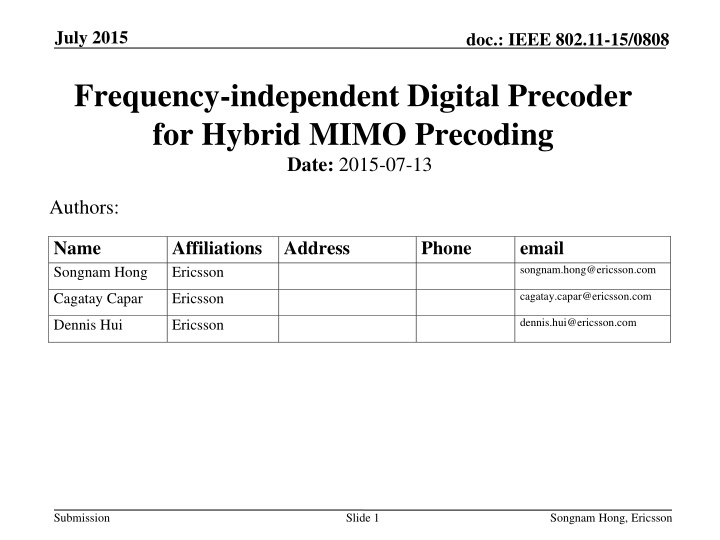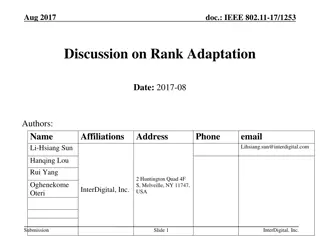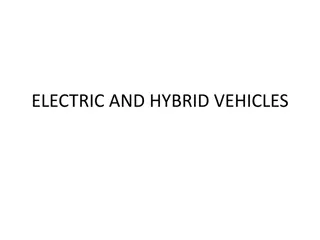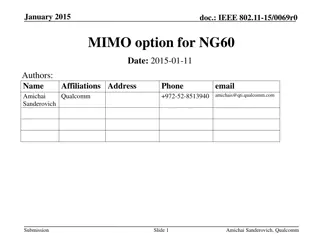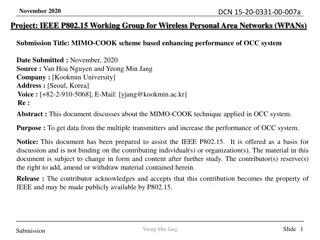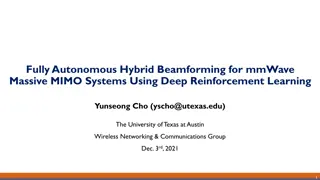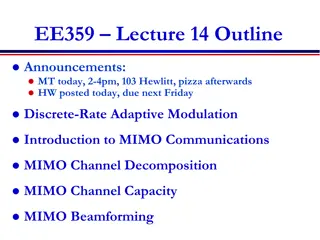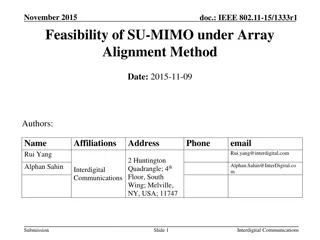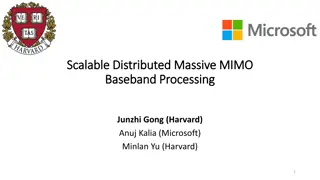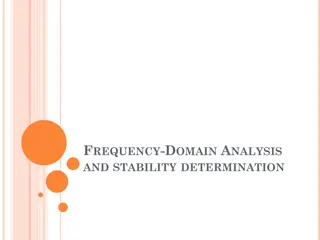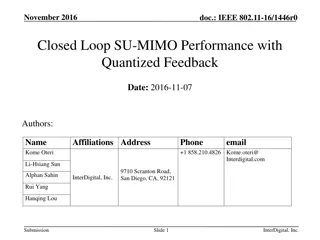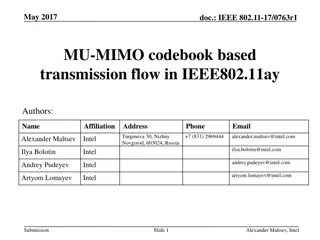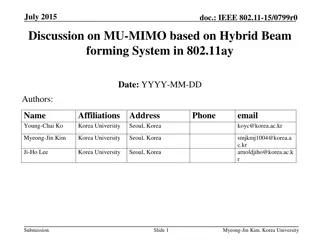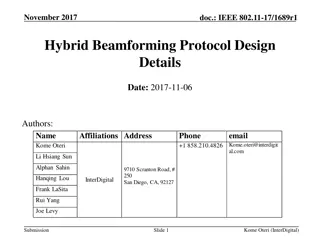Frequency-Independent Digital Precoder for Hybrid MIMO Precoding
This presentation delves into hybrid beamforming with a focus on digital precoding stages for optimal performance. The investigation explores suboptimal choices and feedback reduction impact on performance. It discusses analog and digital precoding, optimal antenna phase shifts, codebook-based analog precoder selection, and optimizing digital precoders for subcarriers.
Download Presentation

Please find below an Image/Link to download the presentation.
The content on the website is provided AS IS for your information and personal use only. It may not be sold, licensed, or shared on other websites without obtaining consent from the author.If you encounter any issues during the download, it is possible that the publisher has removed the file from their server.
You are allowed to download the files provided on this website for personal or commercial use, subject to the condition that they are used lawfully. All files are the property of their respective owners.
The content on the website is provided AS IS for your information and personal use only. It may not be sold, licensed, or shared on other websites without obtaining consent from the author.
E N D
Presentation Transcript
July 2015 doc.: IEEE 802.11-15/0808 Frequency-independent Digital Precoder for Hybrid MIMO Precoding Date: 2015-07-13 Authors: Name Songnam Hong Affiliations Address Ericsson Phone email songnam.hong@ericsson.com cagatay.capar@ericsson.com Cagatay Capar Ericsson dennis.hui@ericsson.com Dennis Hui Ericsson Submission Slide 1 Songnam Hong, Ericsson
July 2015 doc.: IEEE 802.11-15/0808 Abstract In hybrid beamforming [1], precoding is performed two stages: Digital (baseband) precoding and Analog (RF) precoding Typically, the same analog precoder is used for all subcarriers (Frequency-independent). On the other hand, the optimal digital precoder can be selected for each subcarrier, yielding the best performance [2]; however it requires extensive feedback. In this presentation, we investigate how suboptimal choices (with reduced feedback) affect the performance. Submission Slide 2 Songnam Hong, Ericsson
July 2015 doc.: IEEE 802.11-15/0808 Hybrid Beamforming ?RF ? = ? ? + ? RF RF ?BB s BB BB ? = ?? = ?RF?BB? RF RF 1) Analog (Coarse) beamforming: Optimal antenna phase shifts are selected. Codebook-based analog precoder selection (i.e., beam selection) is assumed as in [2]. ?RF and ?RF are chosen from a finite set (i.e., codebook). Exhaustive search is assumed to find the optimal analog precoders (with respect to maximizing the objective function). Submission Slide 3 Songnam Hong, Ericsson
July 2015 doc.: IEEE 802.11-15/0808 Hybrid Beamforming ?RF ? = ? ? + ? RF RF ?BB s BB BB ? = ?? = ?RF?BB? RF RF 2) Baseband (fine) beamforming: Baseband precoding/combining is done. Channel as seen from the baseband for subcarrier f : ?(?)?RF, ?b? = ?RF for ? = 1, ,??, where ?? denotes the number of used subcarriers. Digital precoders are optimized for given effective cahnnel matrices. Submission Slide 4 Songnam Hong, Ericsson
July 2015 doc.: IEEE 802.11-15/0808 Optimizing the Digital Precoders The best performance can be attained by using an optimal digital precoder per each subcarrier; however it requires extensive feedback ?BB? :? = ?, ,??. To reduce the feedback, we can use the same digital precoder per each chunk (i.e., groups of subcarriers), being able to reduce the feedback ?BB? :? = ?, ,?? with ? ?. In the following, we compare the two extreme cases of ? = ? (optimal performance) and ? = ? (minimum feedback). Slide 5 Submission Songnam Hong, Ericsson
May 2015 doc.: IEEE 802.11-15/0808 Optimal Digital Precoder ?? 1 ?0?b? ??b ? ) max ?RF, ?RF max ? log2det(? + ?=1 ??Tr{ ?} = ?totalto subject to: ?=1 For given analog precoder/combiner, the baseband channel matrix for subcarrier f is given by ?b? = ?RF Input covariance matrix for subcarrier f: ?= ?BB? ?BB ?(?)?RF (?) Optimal digital precoders are obtained by using SVD together with water filling across subcarriers and layers. Digital precoder ? is used for subcarrier ?. Submission Slide 6 Songnam Hong, Ericsson
May 2015 doc.: IEEE 802.11-15/0808 Frequency-independent Digital Precoder ?? 1 ?0?b? ?b ? ) max ?RF, ?RFmax log2det(? + ?=1 ??Tr{ } = ??Tr{ } = ?totalto subject to: ?=1 For given analog precoder/combiner, the baseband channel matrix for subcarrier f is given by ?b? = ?RF Same digital precoder, , is used for all subcarriers, where = ?BB?BB The frequency-independent digital precoder implies the uniform power allocation across subcarriers, equivalent to per-subcarrier power constraint ?total/??. ?(?)?RF Submission Slide 7 Songnam Hong, Ericsson
May 2015 doc.: IEEE 802.11-15/0808 Frequency-independent Digital Precoder ?? 1 ?0?b? ?b ? ) max ?RF, ?RFmax log2det(? + ?=1 subject to: Tr{ } =?total ??to Optimization is performed using the method in [3]. The input covariance = ? ? is found in two steps: 1) The eigenvectors of (i.e.,?) are taken as the eigenvectors of ? ?b ?b. ???b 1 ?b = ? ?b(?) ? ?b ?? ?=1 2) The eigenvalues of (i.e., ) are found using an iterative algorithm. Submission Slide 8 Songnam Hong, Ericsson
July 2015 doc.: IEEE 802.11-15/0808 Simulation Details Receiver fixed at one location. Several transmitter locations tested. Both transmitter and receiver have two antenna arrays 2x2 MIMO. Antenna arrays are 1x8 linear arrays. For each transmitter location, full channel matrix (16x16) is generated by ray tracing. Studio apartment room plan: Rx 3 1 Tx 2 4 5 Submission Slide 9 Songnam Hong, Ericsson
July 2015 doc.: IEEE 802.11-15/0808 Simulation Details Studio apartment room plan: For each location, two rate values are calculated: Rates achieved with solving Optimization Problem 1 and 2 (frequency-dependent and frequency- independent digital precoder). Rx 3 1 Tx 2 Results are generated for varying total transmit power values. 4 5 Submission Slide 10 Songnam Hong, Ericsson
July 2015 doc.: IEEE 802.11-15/0808 Simulation Results 1 2 Submission Slide 11 Songnam Hong, Ericsson
July 2015 doc.: IEEE 802.11-15/0808 Simulation Results In all locations, the loss is minimal: a single digital precoder performs very close to an optimized digital precoder per subcarrier. 5 This is mostly due to the frequency selectivity of the channel being low enough so that power allocation across subcarriers is not crucial. In Open-loop MIMO (no precoding at Tx), we observed that there is a performance loss (about 0.5 bits/subcarrier). Submission Slide 12 Songnam Hong, Ericsson
July 2015 doc.: IEEE 802.11-15/0808 Summary and Conclusions We studied the design of the digital precoder for hybrid beamforming in 11ay. For a simple studio apartment room scenario, we have noticed minimal performance loss when all subcarriers use the same digital precoder that is optimized using the method in [3]. The performance gap might be larger when frequency selectivity of the channel is higher (for example, shopping mall scenario). Submission Slide 13 Songnam Hong, Ericsson
July 2015 doc.: IEEE 802.11-15/0808 References 1. 11-14/0606r0, Next Generation 802.11ad: 30+ Gbps WLAN 2. 11-15/0627r0, Beam Selection for Hybrid MIMO Precoding 3. A. Tulino, A. Lozano, and S. Verdu, Capacity-achieving input covariance for single-user multi-antenna channels, IEEE Transactions on Wireless Communications, vol. 5, no. 3, pp. 662-671, March 2006. 4. 11-09/0334r8, Channel Models for 60 GHz WLAN Systems Submission Slide 14 Songnam Hong, Ericsson
